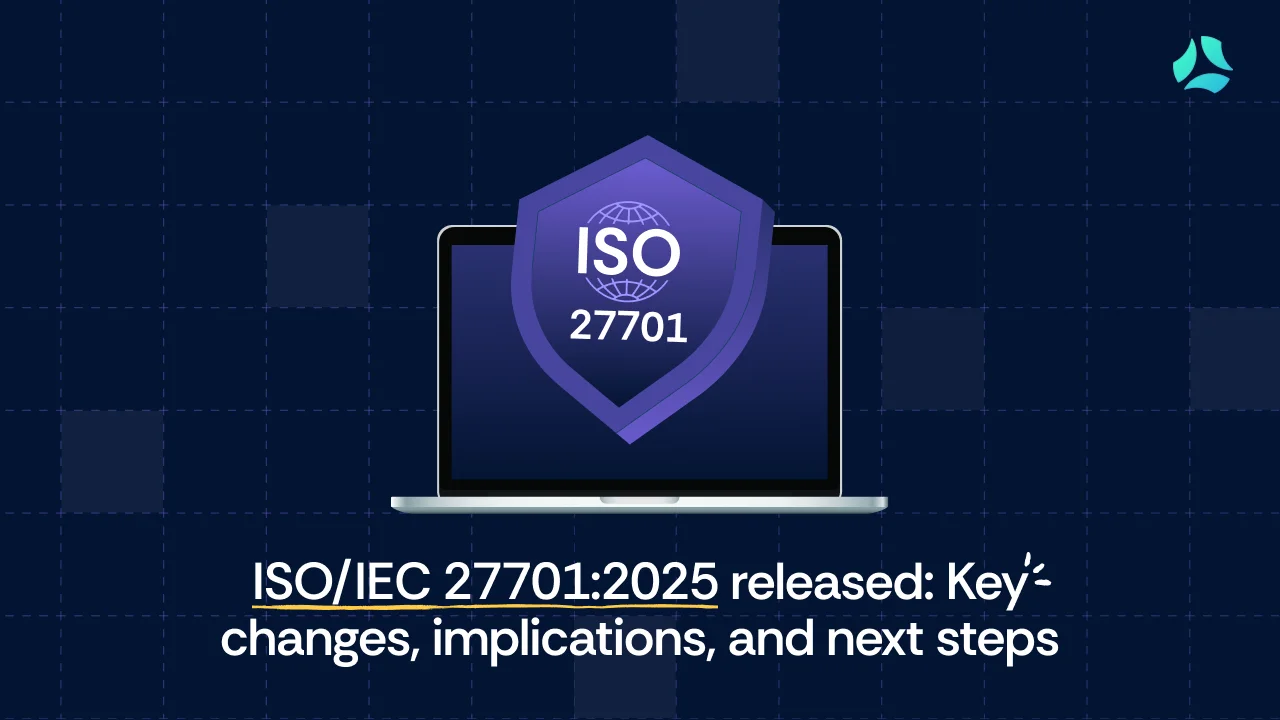Scrut's Access Review module: Automate, validate, and secure your access reviews

Manual access reviews are error-prone, leading to compliance gaps, audit delays, and security risks. Spreadsheets and disconnected systems cause inconsistencies and slow access removal.
Scrut’s Access Review Module automates the process, integrating with identity providers to eliminate manual tracking, streamline approvals, and ensure only authorized users have access.
The challenges of manual access reviews
Many organizations still rely on outdated methods—like spreadsheets and email reminders—to track and complete access reviews. These manual approaches quickly become unsustainable as the organization grows.

- Lack of tracking and visibility – IT teams manually monitor pending, completed, and skipped reviews.
- Delayed revocations and security risks – Ex-employees and vendors often retain access for too long.
- Heavy manual workload – Reviewing hundreds of accounts manually is time-consuming and prone to errors.
- Compliance failures – Regulatory frameworks like SOC 2, ISO 27001, HIPAA mandate periodic reviews, yet manual processes struggle to provide audit-ready proof.
The result? Security risks, compliance violations, and inefficiencies that put organizations at risk of costly breaches and regulatory fines.
The power of automation in access reviews
Automated systems pull data from various sources, validate user permissions, and accelerate accurate reviews. Real-time monitoring ensures continuous oversight, automatic evidence collection, risk alerts, and audit-ready reporting.
This approach enhances transparency, swiftly mitigates risks, and automates access reviews—boosting security, ensuring compliance, and saving time.
Industry use cases
Automated access reviews benefit all industries, particularly those with strict compliance and security requirements. The module is designed for IT administrators, security teams, compliance officers, and risk management professionals responsible for managing user access to critical applications.
- Fintech – Prevent unauthorized access to financial data and ensure regulatory compliance.
- Healthtech – Maintain strict data security with automated access monitoring and structured audit reporting.
- SaaS – Secure third-party and contractor access, minimizing risks from temporary permissions.
- Edutech – Protect sensitive student data with robust access controls and compliance-driven monitoring.
What Is Scrut’s automated Access Review Module?
Scrut’s automated Access Review Module streamlines user access reviews across IT systems and cloud environments. It eliminates manual tracking, automates approvals, and ensures only authorized users have access.
It standardizes periodic reviews by pulling real-time data, flagging high-risk accounts to ensure only authorized users can access critical systems and data, and generating audit-ready reports.

Key capabilities of Scrut’s Access Review Module
Scrut’s Access Reviews module offers a comprehensive suite of features designed to automate and simplify your user access reviews, ensuring robust security and compliance. Here’s an overview of its key capabilities:
1. Integrated and automated workflows
- Pulls access data directly from SSO, IAM, HR systems, and other application integrations—eliminating manual uploads.
- Supports manual CSV uploads for non-integrated applications.
- Enhances ticketing and review workflows by automating Jira ticket creation for recurring evidence tasks.
- Expands ITSM integrations, now supporting Jira, Zendesk, PingOne PingIdentity for SSO login, Trello for project management and ticketing, and more.
2. Advanced review features
- Automatically flags high-risk accounts, including ex-employees and users with excessive administrative privileges. Reviewers can focus on critical accounts first, improving security.
- Enables recurring reviews with automated scheduling to maintain up-to-date access permissions.
- Provides real-time risk insights by detecting access anomalies.
3. Structured review approval and review validation
- Implements a two-step approval process where reviewers propose access changes (approve, revoke, modify) and approvers validate them before finalization. This ensures that multiple stakeholders thoroughly vet any changes to user permissions before being finalized. This is vital because many auditors demand a second-level sign-off by someone other than the initial reviewer.
- Features a “Validate Review” function that syncs via API to confirm that access changes—whether approvals, revocations, or adjustments—have been successfully applied. This ensures you can instantly detect and correct missed changes, eliminate manual checks with one-click verification, and provide real-time validation for auditors.
4. Compliance-ready reporting
- Generates audit-ready reports that detail every approval, revocation, and modification
- Includes user access data, comprehensive justification logs for approval or rejection, ticket links, time stamps, reviewer details, and status tracking for full transparency. These exportable reports (in CSV or PDF format) provide full transparency, reduce administrative burdens, and serve as a critical resource during audits.
- Allows reviewers to attach supporting files (e.g., screenshots) for enhanced audit evidence.
5. Automated notifications and reminders
- Sends clear notifications and reminders to system owners and reviewers, ensuring timely action.
- Tracks upcoming access reviews and recurrence schedules to prevent missed reviews.
6. Intuitive user interface
- Features an easy-to-use graphical timeline and real-time dashboards, the user interface allows you to monitor review progress at a glance.
- Displays real-time access overviews across all applications, highlighting pending actions, flagged risks, and completion status.
7. Continuous monitoring
- Scrut continuously monitors user access, automatically triggering risk alerts and updating dashboards in real time. This ensures anomalies are promptly flagged and addressed, enabling efficient, automated access reviews.
The result?
- Faster, more accurate access reviews
- Reduced security risks from outdated permissions
- Simplified compliance and audit readiness
Key benefits of automating access reviews with Scrut
Manually conducting access reviews is time-consuming, error-prone, and inefficient—especially for growing organizations handling multiple applications and compliance requirements. Automating the process delivers significant security, efficiency, and compliance advantages.
Saves time and reduces manual effort
- 50%+ reduction in manual workload by automating access validation, approvals, and reporting.
- Bulk approval and revocation features allow reviewers to take action on multiple accounts at once.
- Automated notifications and reminders ensure reviews are completed on time, eliminating follow-ups.
Prevents security risks and unauthorized access
- Detects and flags high-risk accounts—such as ex-employees, inactive users, and overprivileged admin accounts.
- Validates access changes in real time to ensure revocations are properly applied across all systems.
- Minimizes insider threats and data breaches by continuously monitoring user access.
Ensures compliance with industry regulations
- Generates audit-ready reports for SOC 2, ISO 27001, HIPAA, GDPR, SOX, and other compliance frameworks.
- Time-stamped logs with approval records provide clear evidence of completed reviews for auditors.
- Automates recurring access reviews to meet regulatory and security requirements without delays.
Improves accuracy and accountability
- Removes spreadsheet-based errors by integrating directly with identity and HR systems.
- Role-Based Access Control (RBAC) ensures proper separation of duties—reviewers suggest changes, and approvers validate them.
- Provides a clear audit trail with justification logs, approval timestamps, and supporting attachments.
Wrapping up
Now is the time to rethink your access review processes. Are manual methods slowing you down with errors and inefficiencies? Experience the power of automation with Scrut.

FAQs
How does the Access Review Module differ from traditional access reviews?
Unlike traditional reviews that rely on spreadsheets, emails, and manual approvals, this module automates the entire process. It integrates directly with identity providers and business-critical systems, assigns tasks based on role-based workflows, validates changes through API synchronization, and produces detailed, audit-ready reports.
How does the module ensure compliance and audit readiness?
The module supports compliance by generating comprehensive reports that include access logs, approval/revocation records, and detailed justification logs. These audit-ready reports, available in exportable formats like CSV and PDF, help meet regulatory requirements (e.g., SOC 2, ISO 27001, HIPAA) and simplify the audit process.
What are the key benefits of using the Access Review Module?
It significantly reduces manual effort and errors, enhances operational efficiency, and proactively flags high-risk accounts (such as ex-employees or users with excessive privileges). Continuous monitoring and automated risk alerts further ensure that your organization maintains secure, compliant access management.


















